MG413 Data Insights: Quantitative & Qualitative Research in Marketing
VerifiedAdded on 2023/06/10
|16
|1199
|285
Report
AI Summary
This report explores the concept of data insights and its various facets within modern marketing research. It highlights the roles of both quantitative and qualitative research methodologies, emphasizing their importance in understanding market trends and consumer behavior. The report also delves into correlation and regression techniques, as well as time series analysis, discussing their applications and drawbacks in business decision-making. Furthermore, it addresses the collection and effective utilization of big data, underscoring the significance of accurate and reliable data for informed decision-making. The report concludes by summarizing the key findings and emphasizing the value of data-driven approaches in contemporary business environments. Desklib provides access to this report and many other solved assignments and past papers.

MG413 DATA
INSIGHTS
INSIGHTS
Paraphrase This Document
Need a fresh take? Get an instant paraphrase of this document with our AI Paraphraser

Submitted by:-
1). Suwarna Thayaparan
LSST ID NO: H2001609
BNU ID NO: 21947514
2). Urszula Kowalska
LSST ID NO: H2009723
BNU ID NO: 22026385
3). Leon Jon Vacher
LSST ID NO: H2009251
BNU ID NO: 22023410
1). Suwarna Thayaparan
LSST ID NO: H2001609
BNU ID NO: 21947514
2). Urszula Kowalska
LSST ID NO: H2009723
BNU ID NO: 22026385
3). Leon Jon Vacher
LSST ID NO: H2009251
BNU ID NO: 22023410
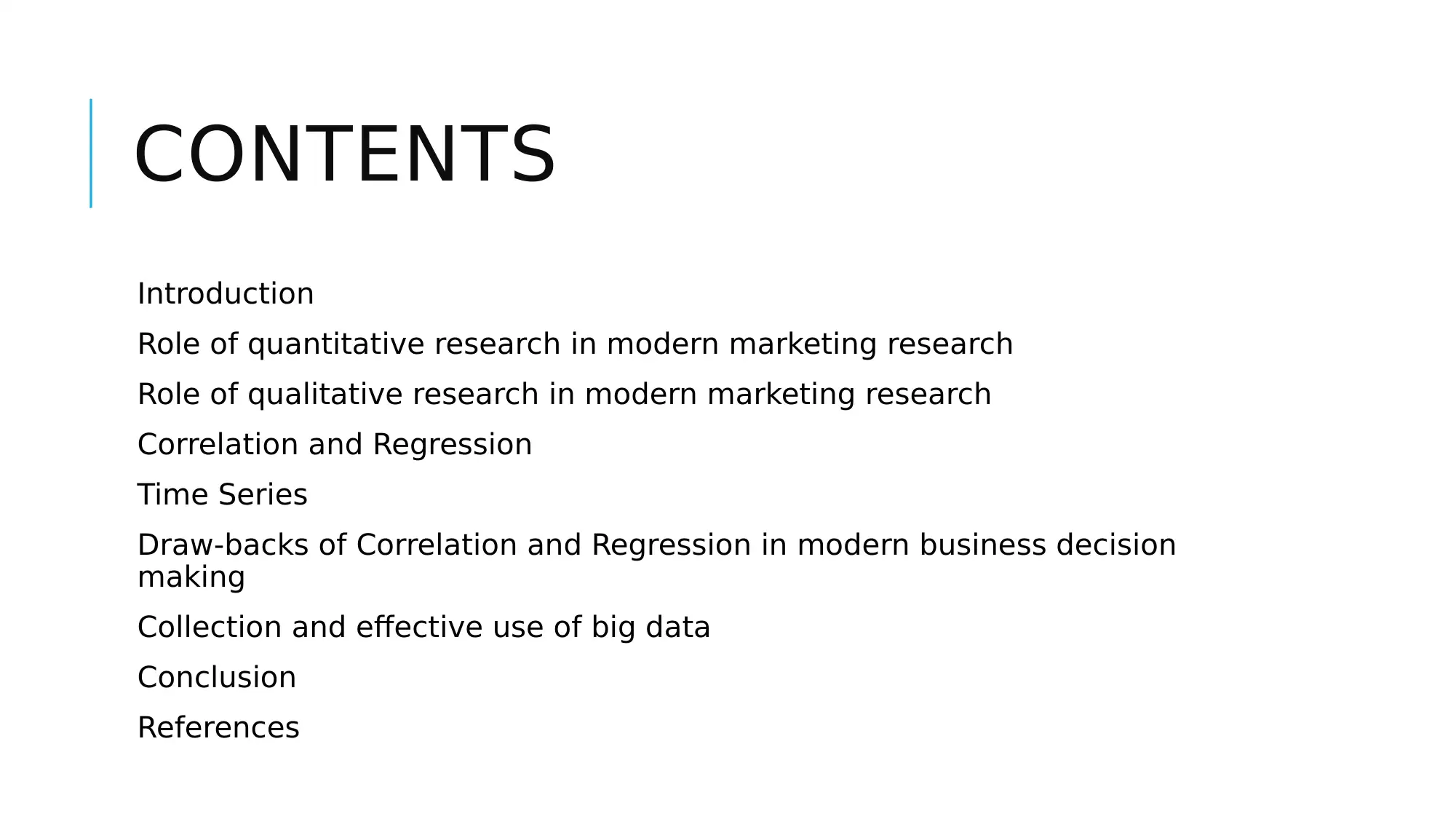
CONTENTS
Introduction
Role of quantitative research in modern marketing research
Role of qualitative research in modern marketing research
Correlation and Regression
Time Series
Draw-backs of Correlation and Regression in modern business decision
making
Collection and effective use of big data
Conclusion
References
Introduction
Role of quantitative research in modern marketing research
Role of qualitative research in modern marketing research
Correlation and Regression
Time Series
Draw-backs of Correlation and Regression in modern business decision
making
Collection and effective use of big data
Conclusion
References
⊘ This is a preview!⊘
Do you want full access?
Subscribe today to unlock all pages.

Trusted by 1+ million students worldwide
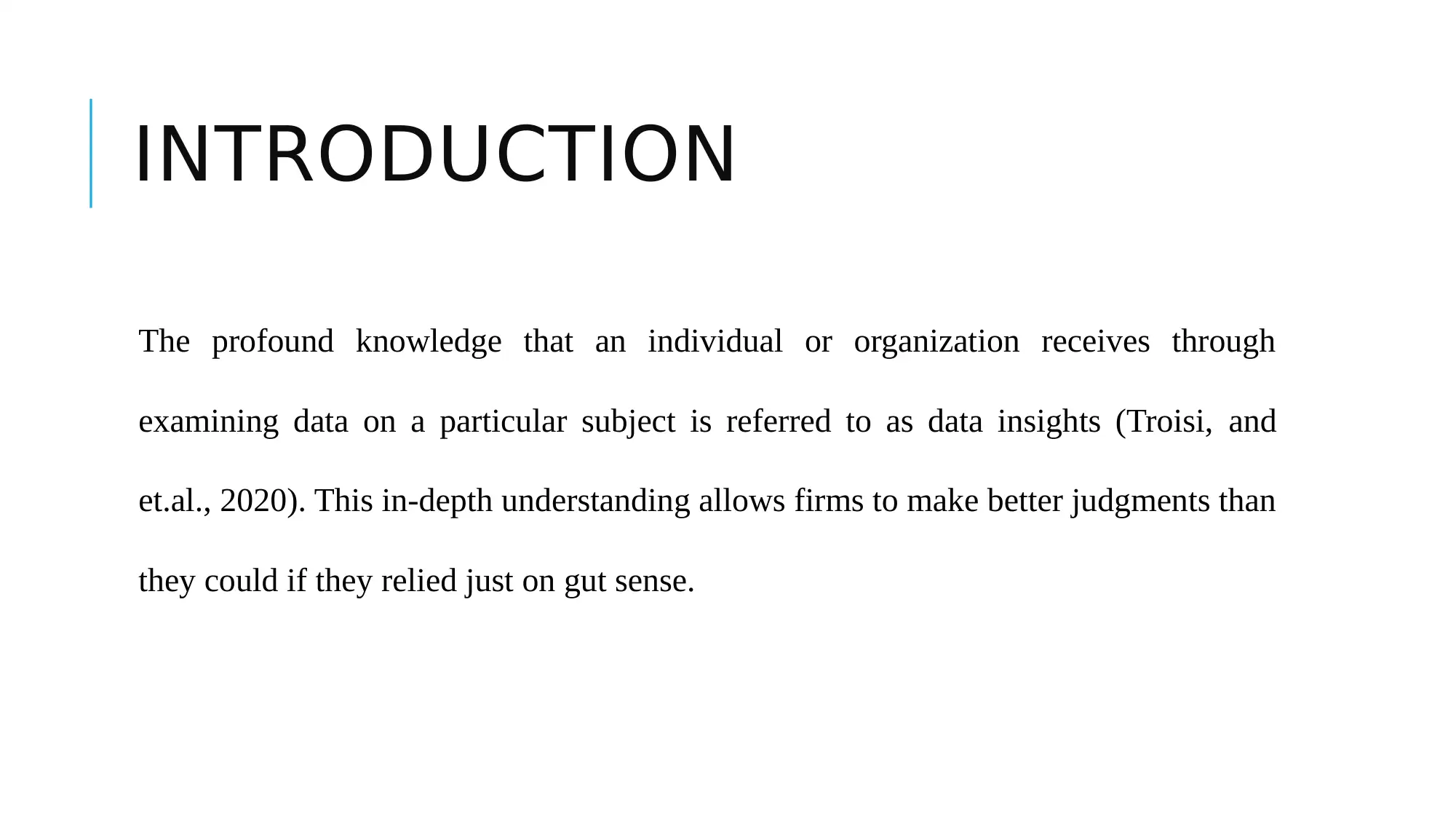
INTRODUCTION
The profound knowledge that an individual or organization receives through
examining data on a particular subject is referred to as data insights (Troisi, and
et.al., 2020). This in-depth understanding allows firms to make better judgments than
they could if they relied just on gut sense.
The profound knowledge that an individual or organization receives through
examining data on a particular subject is referred to as data insights (Troisi, and
et.al., 2020). This in-depth understanding allows firms to make better judgments than
they could if they relied just on gut sense.
Paraphrase This Document
Need a fresh take? Get an instant paraphrase of this document with our AI Paraphraser
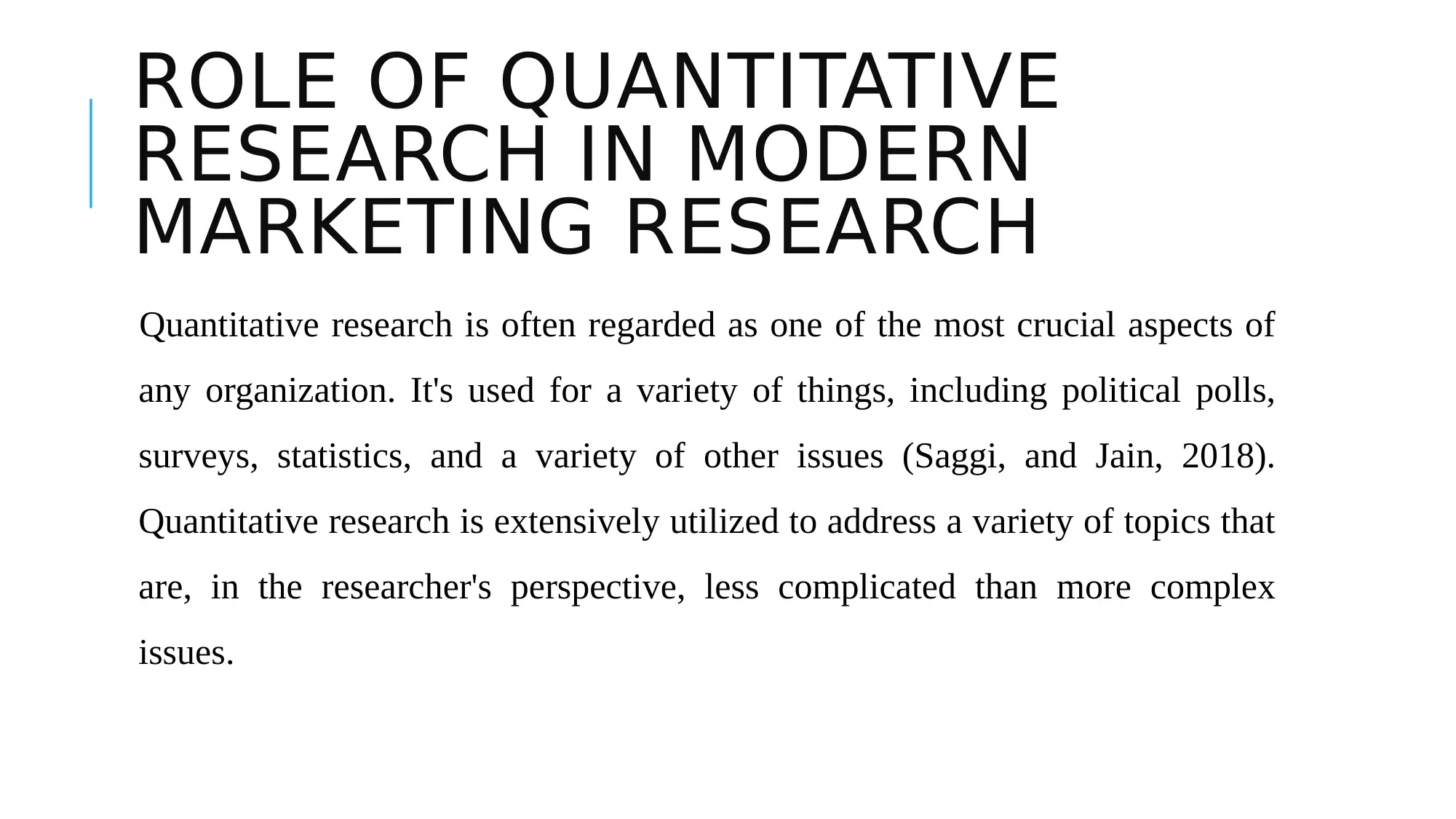
ROLE OF QUANTITATIVE
RESEARCH IN MODERN
MARKETING RESEARCH
Quantitative research is often regarded as one of the most crucial aspects of
any organization. It's used for a variety of things, including political polls,
surveys, statistics, and a variety of other issues (Saggi, and Jain, 2018).
Quantitative research is extensively utilized to address a variety of topics that
are, in the researcher's perspective, less complicated than more complex
issues.
RESEARCH IN MODERN
MARKETING RESEARCH
Quantitative research is often regarded as one of the most crucial aspects of
any organization. It's used for a variety of things, including political polls,
surveys, statistics, and a variety of other issues (Saggi, and Jain, 2018).
Quantitative research is extensively utilized to address a variety of topics that
are, in the researcher's perspective, less complicated than more complex
issues.
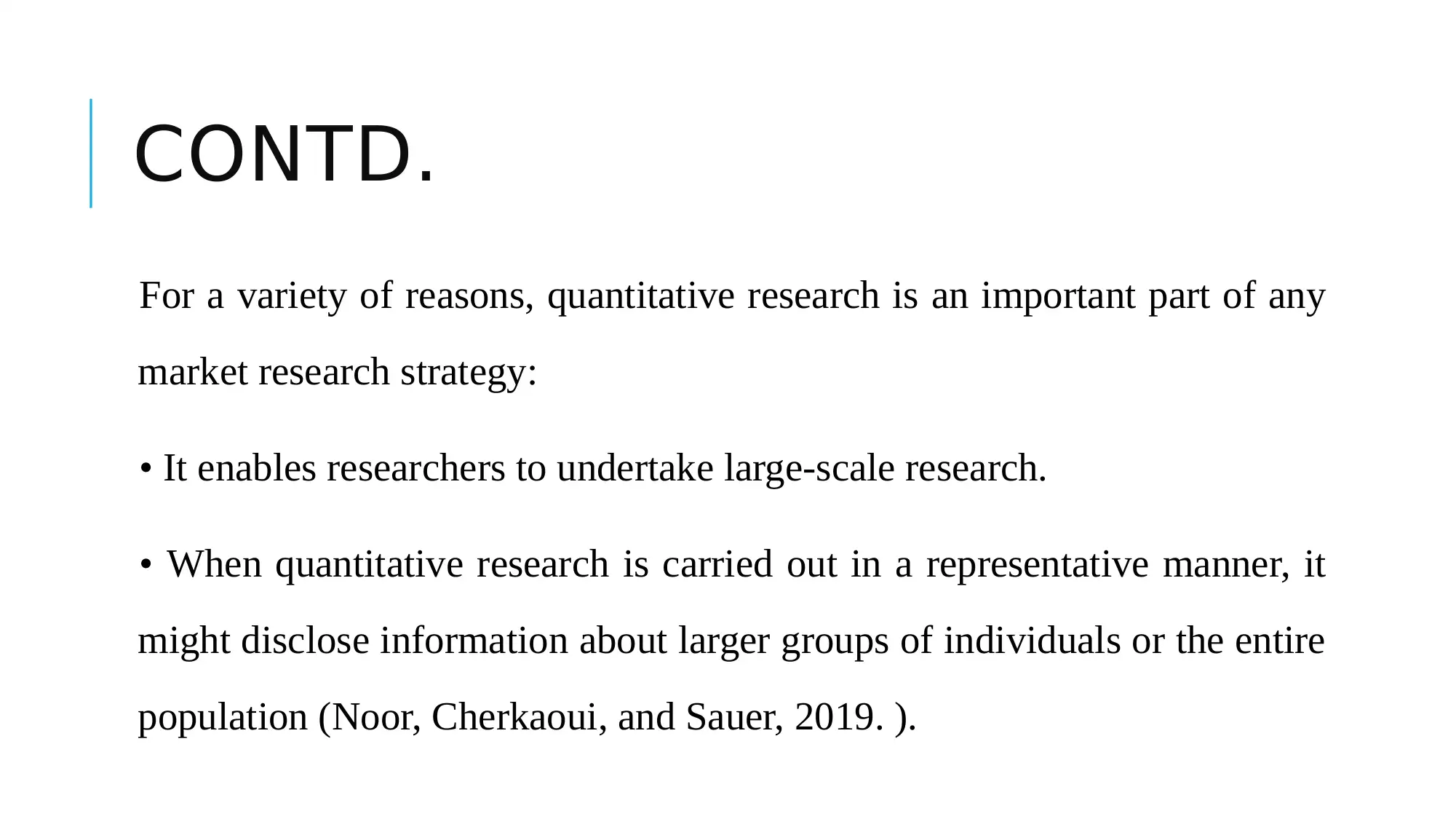
CONTD.
For a variety of reasons, quantitative research is an important part of any
market research strategy:
• It enables researchers to undertake large-scale research.
• When quantitative research is carried out in a representative manner, it
might disclose information about larger groups of individuals or the entire
population (Noor, Cherkaoui, and Sauer, 2019. ).
For a variety of reasons, quantitative research is an important part of any
market research strategy:
• It enables researchers to undertake large-scale research.
• When quantitative research is carried out in a representative manner, it
might disclose information about larger groups of individuals or the entire
population (Noor, Cherkaoui, and Sauer, 2019. ).
⊘ This is a preview!⊘
Do you want full access?
Subscribe today to unlock all pages.

Trusted by 1+ million students worldwide
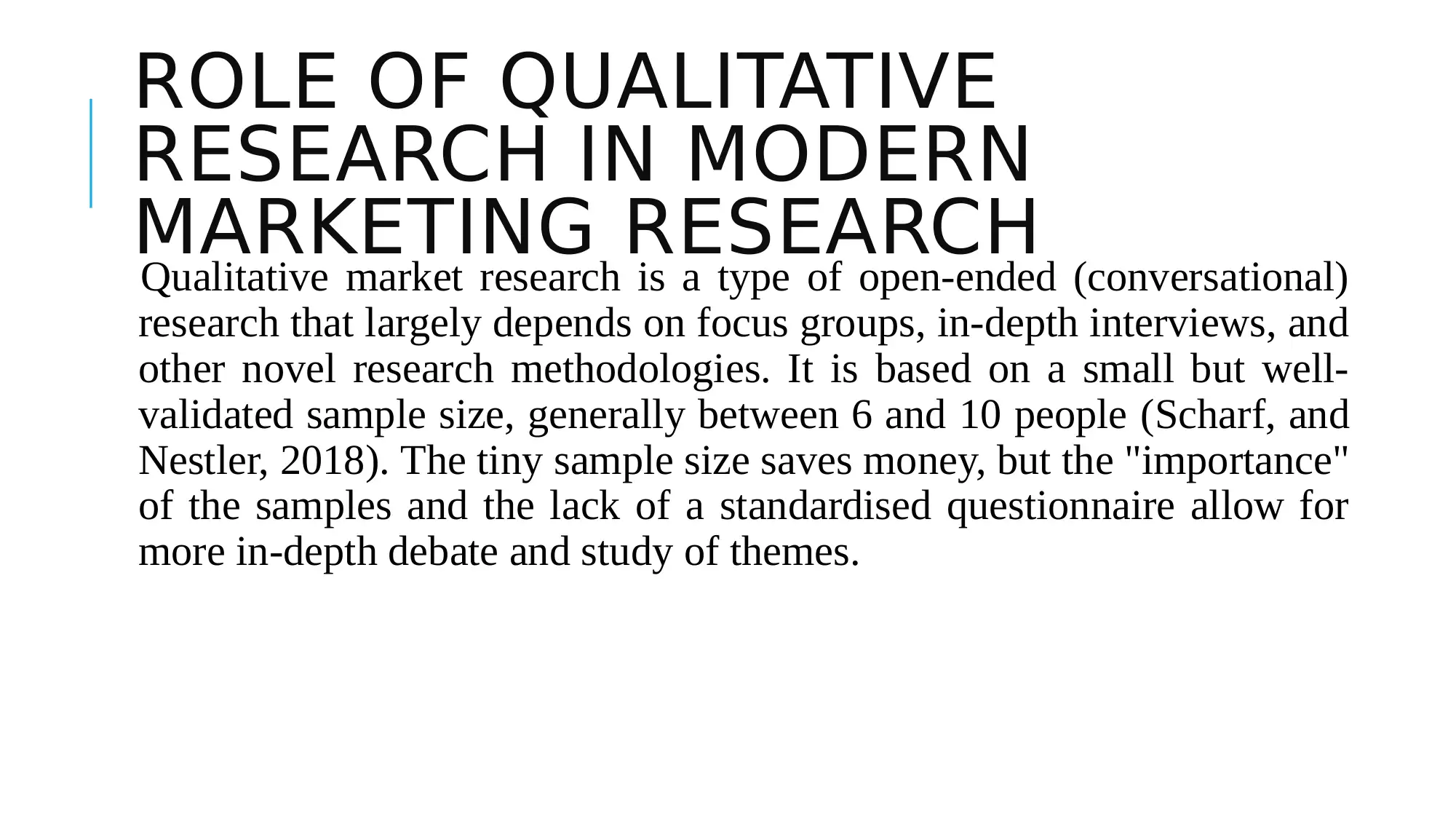
ROLE OF QUALITATIVE
RESEARCH IN MODERN
MARKETING RESEARCHQualitative market research is a type of open-ended (conversational)
research that largely depends on focus groups, in-depth interviews, and
other novel research methodologies. It is based on a small but well-
validated sample size, generally between 6 and 10 people (Scharf, and
Nestler, 2018). The tiny sample size saves money, but the "importance"
of the samples and the lack of a standardised questionnaire allow for
more in-depth debate and study of themes.
RESEARCH IN MODERN
MARKETING RESEARCHQualitative market research is a type of open-ended (conversational)
research that largely depends on focus groups, in-depth interviews, and
other novel research methodologies. It is based on a small but well-
validated sample size, generally between 6 and 10 people (Scharf, and
Nestler, 2018). The tiny sample size saves money, but the "importance"
of the samples and the lack of a standardised questionnaire allow for
more in-depth debate and study of themes.
Paraphrase This Document
Need a fresh take? Get an instant paraphrase of this document with our AI Paraphraser
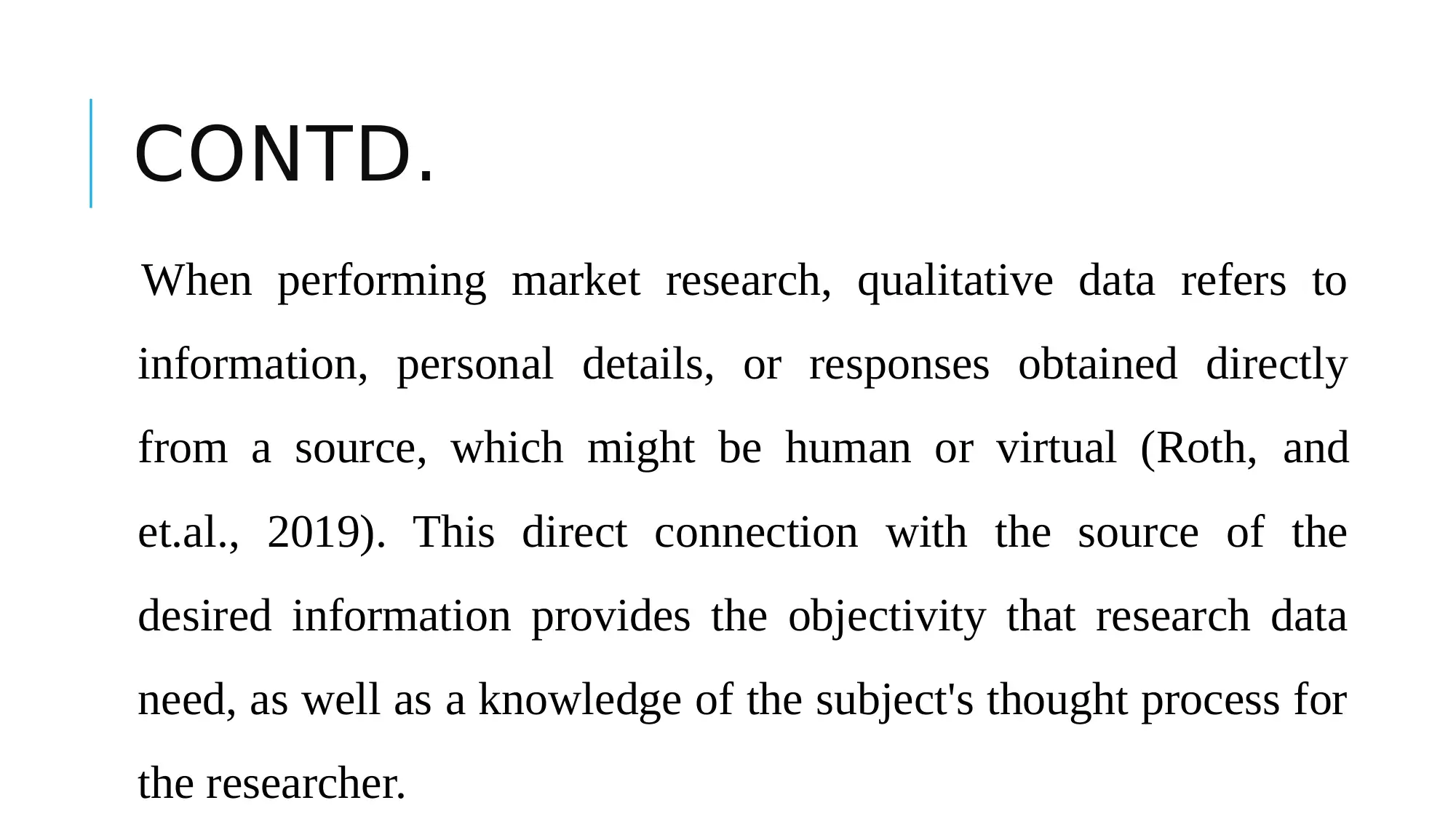
CONTD.
When performing market research, qualitative data refers to
information, personal details, or responses obtained directly
from a source, which might be human or virtual (Roth, and
et.al., 2019). This direct connection with the source of the
desired information provides the objectivity that research data
need, as well as a knowledge of the subject's thought process for
the researcher.
When performing market research, qualitative data refers to
information, personal details, or responses obtained directly
from a source, which might be human or virtual (Roth, and
et.al., 2019). This direct connection with the source of the
desired information provides the objectivity that research data
need, as well as a knowledge of the subject's thought process for
the researcher.
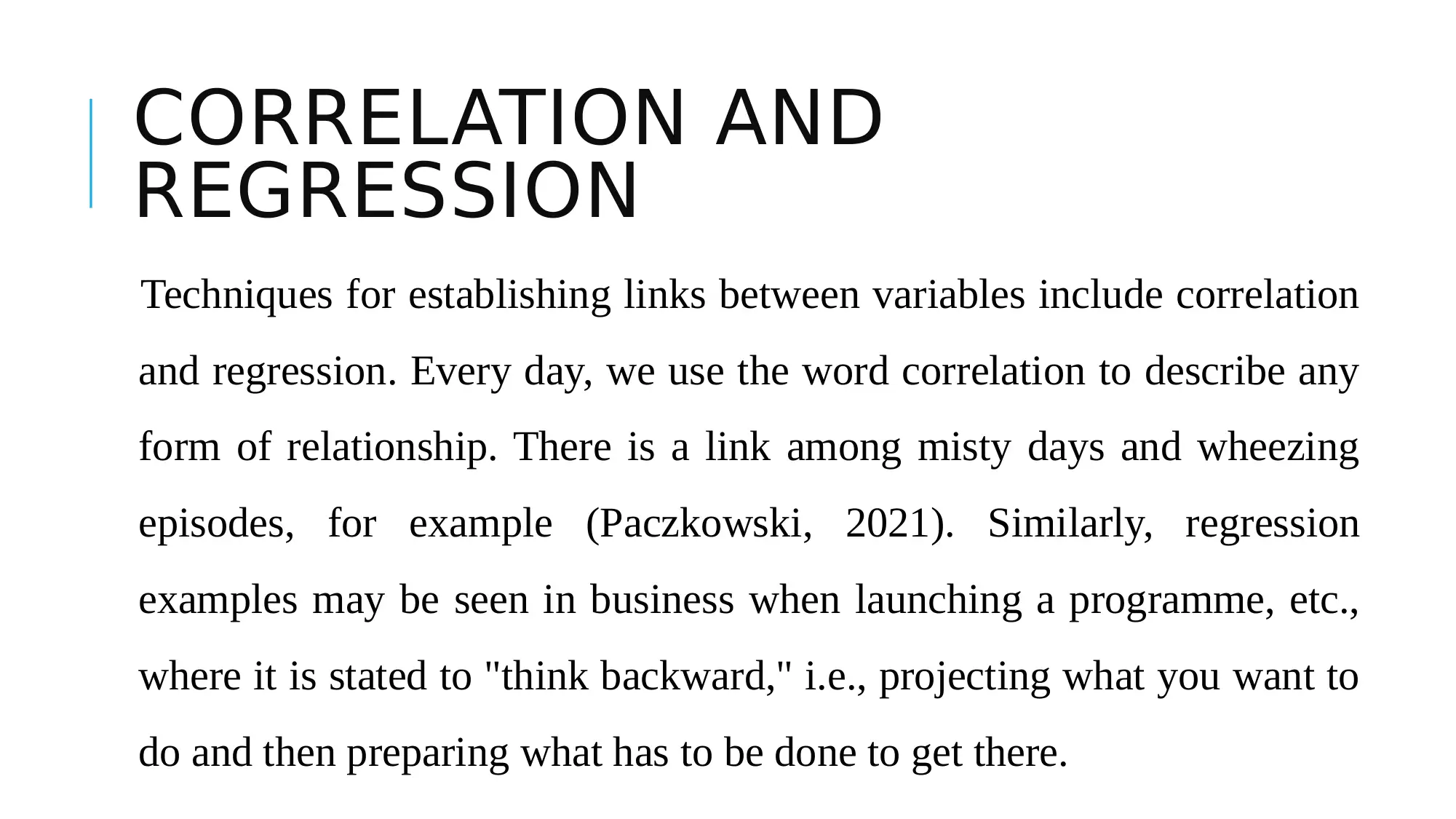
CORRELATION AND
REGRESSION
Techniques for establishing links between variables include correlation
and regression. Every day, we use the word correlation to describe any
form of relationship. There is a link among misty days and wheezing
episodes, for example (Paczkowski, 2021). Similarly, regression
examples may be seen in business when launching a programme, etc.,
where it is stated to "think backward," i.e., projecting what you want to
do and then preparing what has to be done to get there.
REGRESSION
Techniques for establishing links between variables include correlation
and regression. Every day, we use the word correlation to describe any
form of relationship. There is a link among misty days and wheezing
episodes, for example (Paczkowski, 2021). Similarly, regression
examples may be seen in business when launching a programme, etc.,
where it is stated to "think backward," i.e., projecting what you want to
do and then preparing what has to be done to get there.
⊘ This is a preview!⊘
Do you want full access?
Subscribe today to unlock all pages.

Trusted by 1+ million students worldwide
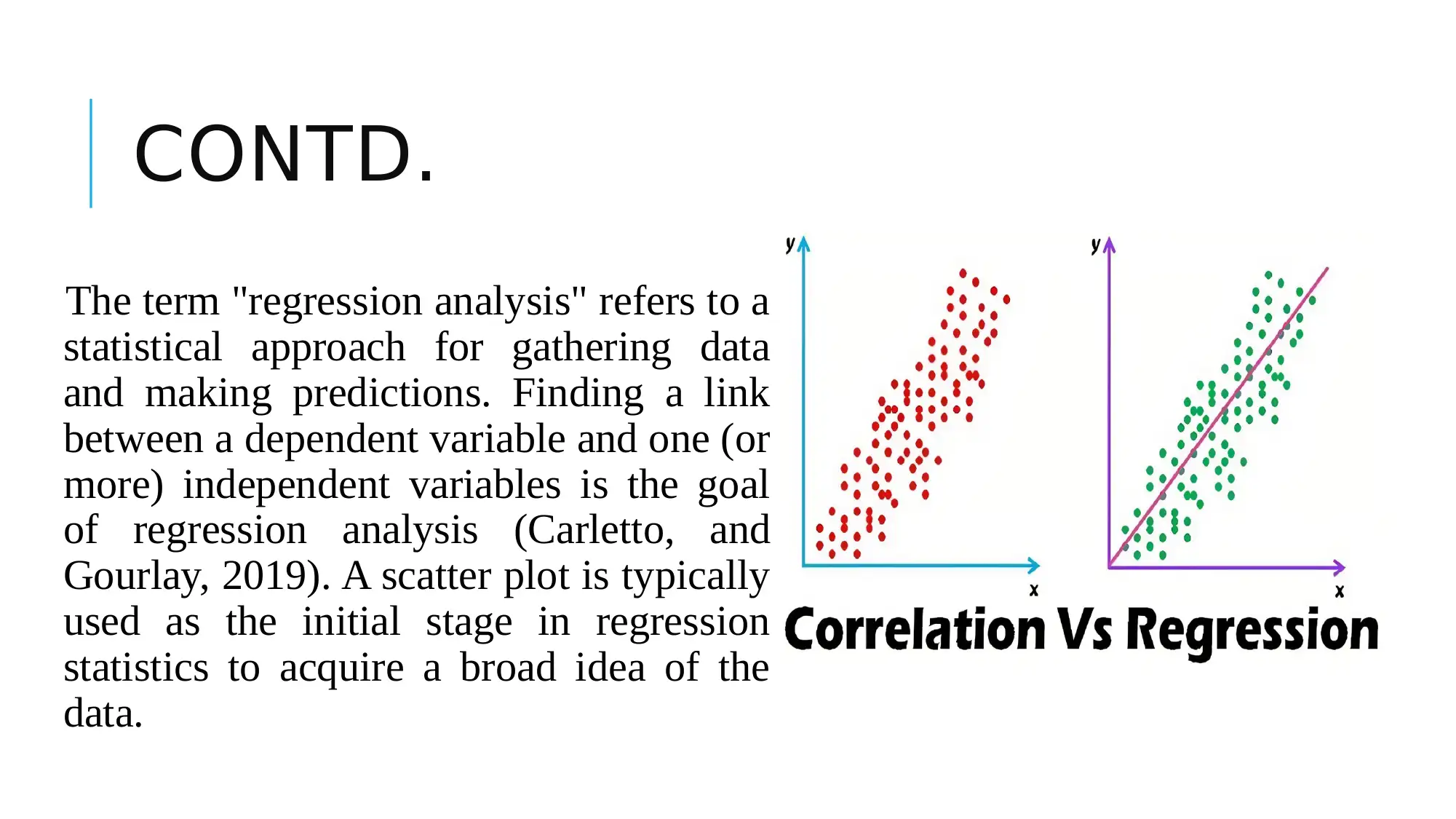
CONTD.
The term "regression analysis" refers to a
statistical approach for gathering data
and making predictions. Finding a link
between a dependent variable and one (or
more) independent variables is the goal
of regression analysis (Carletto, and
Gourlay, 2019). A scatter plot is typically
used as the initial stage in regression
statistics to acquire a broad idea of the
data.
The term "regression analysis" refers to a
statistical approach for gathering data
and making predictions. Finding a link
between a dependent variable and one (or
more) independent variables is the goal
of regression analysis (Carletto, and
Gourlay, 2019). A scatter plot is typically
used as the initial stage in regression
statistics to acquire a broad idea of the
data.
Paraphrase This Document
Need a fresh take? Get an instant paraphrase of this document with our AI Paraphraser
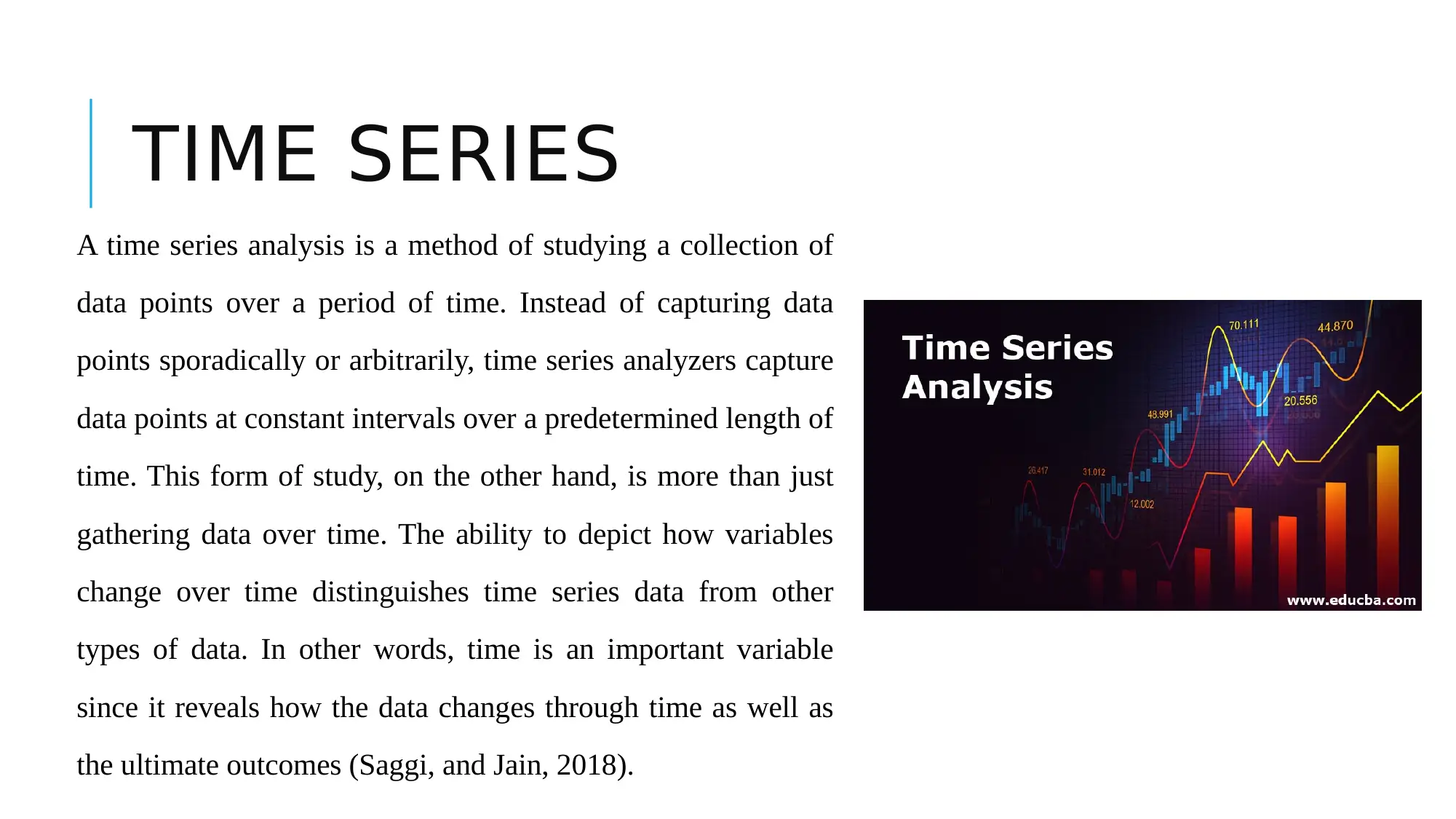
TIME SERIES
A time series analysis is a method of studying a collection of
data points over a period of time. Instead of capturing data
points sporadically or arbitrarily, time series analyzers capture
data points at constant intervals over a predetermined length of
time. This form of study, on the other hand, is more than just
gathering data over time. The ability to depict how variables
change over time distinguishes time series data from other
types of data. In other words, time is an important variable
since it reveals how the data changes through time as well as
the ultimate outcomes (Saggi, and Jain, 2018).
A time series analysis is a method of studying a collection of
data points over a period of time. Instead of capturing data
points sporadically or arbitrarily, time series analyzers capture
data points at constant intervals over a predetermined length of
time. This form of study, on the other hand, is more than just
gathering data over time. The ability to depict how variables
change over time distinguishes time series data from other
types of data. In other words, time is an important variable
since it reveals how the data changes through time as well as
the ultimate outcomes (Saggi, and Jain, 2018).
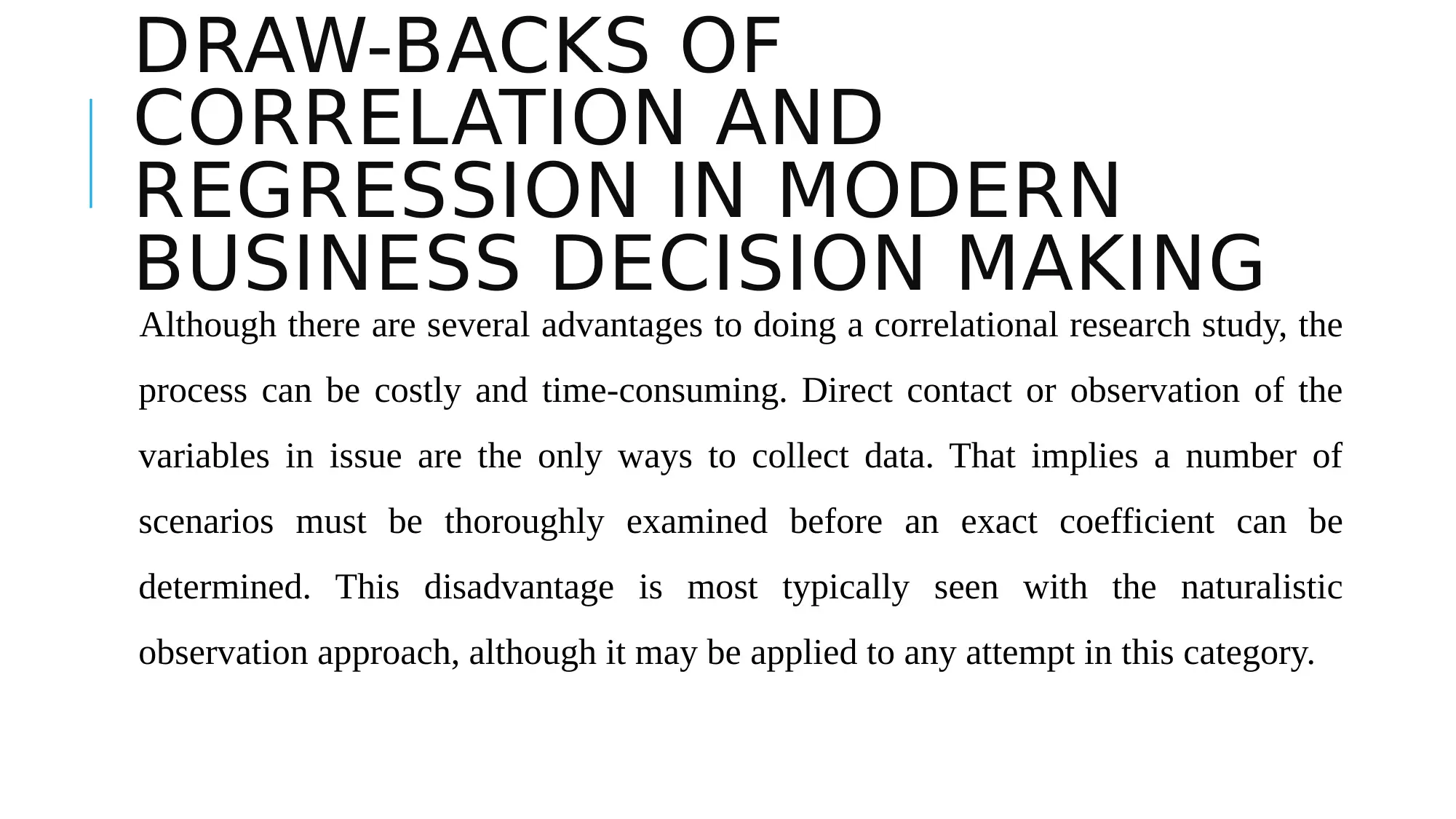
DRAW-BACKS OF
CORRELATION AND
REGRESSION IN MODERN
BUSINESS DECISION MAKING
Although there are several advantages to doing a correlational research study, the
process can be costly and time-consuming. Direct contact or observation of the
variables in issue are the only ways to collect data. That implies a number of
scenarios must be thoroughly examined before an exact coefficient can be
determined. This disadvantage is most typically seen with the naturalistic
observation approach, although it may be applied to any attempt in this category.
CORRELATION AND
REGRESSION IN MODERN
BUSINESS DECISION MAKING
Although there are several advantages to doing a correlational research study, the
process can be costly and time-consuming. Direct contact or observation of the
variables in issue are the only ways to collect data. That implies a number of
scenarios must be thoroughly examined before an exact coefficient can be
determined. This disadvantage is most typically seen with the naturalistic
observation approach, although it may be applied to any attempt in this category.
⊘ This is a preview!⊘
Do you want full access?
Subscribe today to unlock all pages.

Trusted by 1+ million students worldwide
1 out of 16
Related Documents
Your All-in-One AI-Powered Toolkit for Academic Success.
+13062052269
info@desklib.com
Available 24*7 on WhatsApp / Email
![[object Object]](/_next/static/media/star-bottom.7253800d.svg)
Unlock your academic potential
Copyright © 2020–2025 A2Z Services. All Rights Reserved. Developed and managed by ZUCOL.


